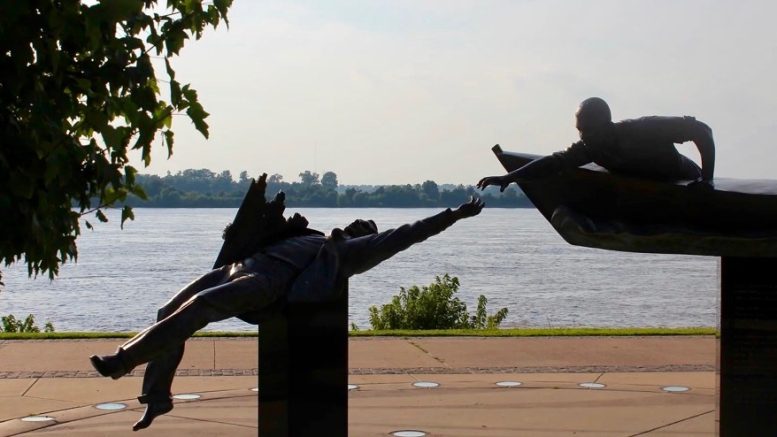By Douglas Cazaux Sackman
At dusk, Tyre Nichols used to ask his friend Angelina Paxton for a ride down the Sacramento River Delta to catch a sunset. They drove her Nissan Maxima to the levee, with young Tyre leaning out the window, throwing high fives to the sky. “It showed his free spirit,” his friend remembered. “I think that’s all he ever wanted. To just feel free.”
When he later moved to Memphis, Nichols continued to chase sunsets on the river, taking photographs over its waters, looking through the lens back west to where he was from. On his photography site (which has “this California Kid” as part of its url), Nichols explained that he loved to photograph bodies of water and landscapes: “My vision is to bring my viewers deep into what I am seeing through my eye and out through my lens.” Nichols caught his last sunset and sliver of freedom the night he was brutally beaten by the police officers of the so-called SCORPION unit.
“I’m just trying to go home,” Nichols explained.
But they stung him—with a taser, with pepper spray—and beat him, and kicked him, and he cried out “mom.”
“Mom,” he cried out again, and again, a primal plea that echoed out onto the river that had heard, in its upper reaches, the same cry before from George Floyd.
Nichols liked to take sunset photographs of the Hernando de Soto bridge over the Mississippi, that storied waterway down the heart of the continent that has freighted so much of this nation’s troubled history. He’d photograph old river boats docked at the shore, looking like that area’s own Delta King. For some, those alabaster steam boats nostalgically evoke an open-hearted place of comradery and freedom, where “you gonna find some people who live [and] are happy to give,” where Huck and Jim make common cause and a home out of a raft, where everyone is “rolling, rolling on the river.” John Fogerty, who grew up at the outlet of the California Delta on the Bay, knew he was singing of a mythical Mississippi river in his song Proud Mary (and in fact he visited Memphis to see the actual river for the first time only after he wrote it). When Blues and Soul artist Solomon Burke covered Credence Clearwater Revival’s hit, he added depth to their song of freedom: “You see, my forefathers used to ride the bottoms of her as stokers, cooks, and waiters.”
One of the most striking photographs Nichols took on the banks of the Mississippi was of a bronze statue created by David Alan Clark for the Urban Arts Commission in 2006. Photographed in a way that evokes Michelangelo’s Sistine Chapel mural, the monument honors the heroism of Tom Lee. Tom Lee was employed on the Mississippi to repair levees, which keep the cities along the river from being inundated. One day in 1925 he noticed a sternwheeler listing badly on the river. Carrying a group of Army Corp of Engineers and their families, the ship went down. Despite not being able to swim himself, Tom Lee steered his small craft to the scene, and began rescuing drowning people, one by one. He saved 32 people that day, saying that it was what anyone would have done in his position. In return, the white community of Memphis was grateful. They raised money to buy him a modest house, and they helped him secure a somewhat safer and better paying job—as a city sanitation worker.
Nichols, who was known for reaching out a helping hand, highlighted the way Tom Lee was reaching out to save the spark of life in his fellow humans. The Sunset Canopy has now been dedicated to Nichols at the park, where Americans can reflect on the power of outstretched arms to help, or to harm. Though Tom Lee saved lives that day in 1925 to create some redemption amidst the horrible tragedy, looking back one sees an ominous foreshadowing. Despite the planning of the Army Corp of Engineers and the repair work people like Tom Lee were constantly doing, two years later the Mississippi river would flood, breaking the levees, causing millions of dollars of damage, displacing 200,000 African Americans and drowning 500 vulnerable people. Memphis Minnie and Kansas Joe McCoy sang about losing homes in the deluge caused by a broken system, in words that ring as true for today – or 2005 – as they did for 1927: “Oh cryin’ won’t help you, prayin’ won’t do no good / Oh cryin’ won’t help you, prayin’ won’t do no good / Whenever the levee breaks momma, you got to lose.”
Walk back five hundred strides from the Tom Lee memorial and you’ll arrive at the Lorraine Hotel, where Dr. Martin Luther King Jr. was gunned down in 1968. That hallowed ground has been turned into the National Civil Rights Museum. King had come to Memphis to join the protest of sanitation workers, whose work conditions were neither safe nor sanitary. He was there to extend a helping hand to the descendants of Tom Lee, working to keep the city clean while drowning in inhumanity. Two sanitation workers had been crushed to death by inadequately maintained machinery. Facing indifference, workers went on strike. They marched on Beale Street wearing placards saying “I am a man.”
In a haunting premonition, the night before he died King told those men and their allies in Memphis that “I would like to live a long life—longevity has its place. But I’m not concerned about that now … I’ve seen the Promised Land. I may not get there with you. But I want you to know tonight that we, as a people, will get to the Promised Land.” But 55 years later, that promised land has yet to be reached—not in Sacramento, where police killed Stephon Clark while holding a cell phone, and not in Memphis, where police used a metal rod to beat Tyre Nichols into the ground.
And not upriver in Ferguson, where Michael Brown was gunned down in the shadow of America’s Gateway Arch, which is meant to celebrate in stainless steel the promise of the West, and by extension, the promise of America. King kept faith that the “the arc of the moral universe is long, but it bends toward justice.” In an odd way, that phrase evokes the graceful arcs traced by Tyre Nichols when he was skateboarding, finding freedom in the half pipe like he did on the levees. As his mother, RowVaughn Wells, shared at a memorial gathering at a skate park in Sacramento, “He always said he felt free when he was on that board. He didn’t worry about anything. He said his mind was free on that board.”
Friends and fellow skaters from middle school held up boards inscribed “Justice for Tyre.” With his board and with his friends, Nichols could keep the forces of gravity at bay and soar with the greatest of ease. People will bend the arc just a little by naming skate parks in Sacramento and Memphis after him, so that others can celebrate his memory rolling on the river.
Wells says, “I will get justice for him if it’s the last thing I do.” She has faith that, “God is not gonna let any of his children’s names go in vain. So, when this is all over, it’s gonna be some good and some positive because my son was a good and positive person.”
Nichols’ mother is hoping for a greater good to come in his wake, and for her sake, and the country’s, people will need justice to roll down like a river.
Douglas Sackman is a professor of history at the University of Puget Sound, and the author of “Wild Men: Ishi and Kroeber in the Wilderness of Modern America.” He has also written for SN&R the piece, ‘Tales of Jedediah Smith in the Sacramento Valley and high Sierra ignore a grim reality.’



Be the first to comment on "Rolling on the rivers: Tyre Nichols’ love for the Sacramento River carried into his life and legacy"